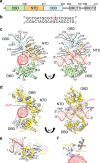Structures of DNA-bound human ligase IV catalytic core reveal insights into substrate binding and catalysis
- PMID: 29980672
- PMCID: PMC6035275
- DOI: 10.1038/s41467-018-05024-8
Structures of DNA-bound human ligase IV catalytic core reveal insights into substrate binding and catalysis
Abstract
DNA ligase IV (LigIV) performs the final DNA nick-sealing step of classical nonhomologous end-joining, which is critical for immunoglobulin gene maturation and efficient repair of genotoxic DNA double-strand breaks. Hypomorphic LigIV mutations cause extreme radiation sensitivity and immunodeficiency in humans. To better understand the unique features of LigIV function, here we report the crystal structure of the catalytic core of human LigIV in complex with a nicked nucleic acid substrate in two distinct states-an open lysyl-AMP intermediate, and a closed DNA-adenylate form. Results from structural and mutagenesis experiments unveil a dynamic LigIV DNA encirclement mechanism characterized by extensive interdomain interactions and active site phosphoanhydride coordination, all of which are required for efficient DNA nick sealing. These studies provide a scaffold for defining impacts of LigIV catalytic core mutations and deficiencies in human LIG4 syndrome.
Conflict of interest statement
The authors declare no competing interests.
Figures








Similar articles
-
Hypomorphic mutations in human DNA ligase IV lead to compromised DNA binding efficiency, hydrophobicity and thermal stability.Protein Eng Des Sel. 2021 Feb 15;34:gzab001. doi: 10.1093/protein/gzab001. Protein Eng Des Sel. 2021. PMID: 33586762
-
Structural insights into the role of domain flexibility in human DNA ligase IV.Structure. 2012 Jul 3;20(7):1212-22. doi: 10.1016/j.str.2012.04.012. Epub 2012 May 31. Structure. 2012. PMID: 22658747 Free PMC article.
-
X-ray scattering reveals disordered linkers and dynamic interfaces in complexes and mechanisms for DNA double-strand break repair impacting cell and cancer biology.Protein Sci. 2021 Sep;30(9):1735-1756. doi: 10.1002/pro.4133. Epub 2021 Jun 5. Protein Sci. 2021. PMID: 34056803 Free PMC article. Review.
-
Structural and functional characterization of the PNKP-XRCC4-LigIV DNA repair complex.Nucleic Acids Res. 2017 Jun 2;45(10):6238-6251. doi: 10.1093/nar/gkx275. Nucleic Acids Res. 2017. PMID: 28453785 Free PMC article.
-
Mammalian DNA ligases; roles in maintaining genome integrity.J Mol Biol. 2024 Jan 1;436(1):168276. doi: 10.1016/j.jmb.2023.168276. Epub 2023 Sep 13. J Mol Biol. 2024. PMID: 37714297 Free PMC article. Review.
Cited by
-
Catalytically inactive DNA ligase IV promotes DNA repair in living cells.Nucleic Acids Res. 2022 Oct 28;50(19):11058-11071. doi: 10.1093/nar/gkac913. Nucleic Acids Res. 2022. PMID: 36263813 Free PMC article.
-
Glycogen synthase kinase-3β inhibitor SB216763 promotes DNA repair in ischemic retinal neurons.Neural Regen Res. 2021 Feb;16(2):394-400. doi: 10.4103/1673-5374.290913. Neural Regen Res. 2021. PMID: 32859805 Free PMC article.
-
Druggable binding sites in the multicomponent assemblies that characterise DNA double-strand-break repair through non-homologous end joining.Essays Biochem. 2020 Oct 26;64(5):791-806. doi: 10.1042/EBC20190092. Essays Biochem. 2020. PMID: 32579168 Free PMC article. Review.
-
The ligation of pol β mismatch insertion products governs the formation of promutagenic base excision DNA repair intermediates.Nucleic Acids Res. 2020 Apr 17;48(7):3708-3721. doi: 10.1093/nar/gkaa151. Nucleic Acids Res. 2020. PMID: 32140717 Free PMC article.
-
Autoimmunity and immunodeficiency associated with monoallelic LIG4 mutations via haploinsufficiency.J Allergy Clin Immunol. 2023 Aug;152(2):500-516. doi: 10.1016/j.jaci.2023.03.022. Epub 2023 Mar 31. J Allergy Clin Immunol. 2023. PMID: 37004747 Free PMC article.
References
Publication types
MeSH terms
Substances
Grants and funding
- ZIA ES102645/ImNIH/Intramural NIH HHS/United States
- Z01 ES065070/ImNIH/Intramural NIH HHS/United States
- Z01 ES065070/ES/NIEHS NIH HHS/United States
- 1Z01 ES102765/U.S. Department of Health & Human Services | NIH | National Institute of Environmental Health Sciences (NIEHS)/International
- 1ZIA ES102645/U.S. Department of Health & Human Services | NIH | National Institute of Environmental Health Sciences (NIEHS)/International
LinkOut - more resources
Full Text Sources
Other Literature Sources
Molecular Biology Databases
Research Materials

